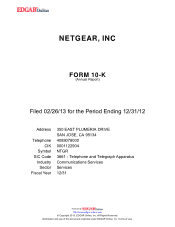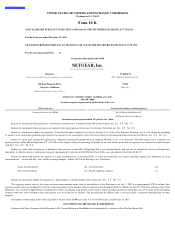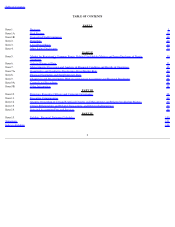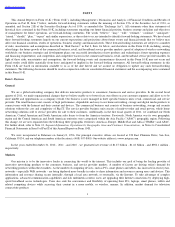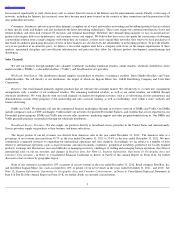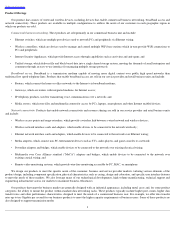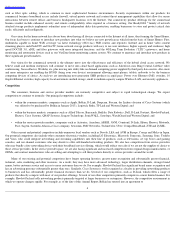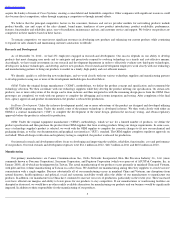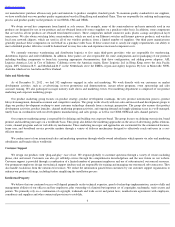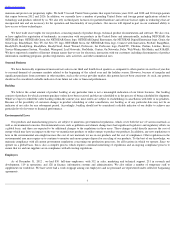Netgear 2012 Annual Report Download - page 9
Download and view the complete annual report
Please find page 9 of the 2012 Netgear annual report below. You can navigate through the pages in the report by either clicking on the pages listed below, or by using the keyword search tool below to find specific information within the annual report.
Table of Contents
acquire the Linksys division of Cisco Systems, creating a consolidated and formidable competitor. Other companies with significant resources could
also become direct competitors, either through acquiring a competitor or through internal efforts.
We believe that the principal competitive factors in the consumer, business and service provider markets for networking products include
product breadth, size and scope of the sales channel, brand name, timeliness of new product introductions, product availability, performance,
features, functionality and reliability, price, ease-of-
installation, maintenance and use, and customer service and support. We believe our products are
competitive in these markets based on these factors.
To remain competitive, we must invest significant resources in developing new products and enhancing our current products while continuing
to expand our sales channels and maintaining customer satisfaction worldwide.
Research and Development
As of December 31, 2012
, we had 251 employees engaged in research and development. Our success depends on our ability to develop
products that meet changing user needs and to anticipate and proactively respond to evolving technology in a timely and cost-
effective manner.
Accordingly, we have made investments in our research and development department in order to effectively evaluate new third-
party technologies,
develop new in-
house technologies, and develop and test new products. Our research and development employees work closely with our technology
and manufacturing partners to bring our products to market in a timely, high quality and cost-efficient manner.
We identify, qualify or self-
develop new technologies, and we work closely with our various technology suppliers and manufacturing partners
to develop products using one or more of the development methodologies described below.
ODM.
Under the original design manufacturer ("ODM"), methodology, we define the product concept and specification and recommend the
technology selection. We then coordinate with our technology suppliers while they develop the product meeting our specification. On certain new
products, one or more subsystems of the design can be done in-
house and then integrated in with the remaining design pieces from the ODM. Once
prototypes are completed, we work with our partners to complete the debugging and systems integration and testing. After completion of the final
tests, agency approvals and product documentation, the product is released for production.
In-House Development. Under the in-
house development model, one or more subsystems of the product are designed and developed utilizing
the NETGEAR engineering team. Under this model, some of the primary technology is developed in-
house. We then work closely with either an
ODM or a contract manufacturer ("CM") to complete the development of the entire design, perform the necessary testing, and obtain regulatory
approvals before the product is released for production.
OEM.
Under the original equipment manufacturer ("OEM"), methodology, which we use for a limited number of products, we define the
product specification and then purchase the product from OEM suppliers that have existing products fitting our design requirements. In some cases,
once a technology supplier's product is selected, we work with the OEM supplier to complete the cosmetic changes to fit into our mechanical and
packaging design, as well as our documentation and graphical user interface ("GUI"), standard. The OEM supplier completes regulatory approvals on
our behalf. When all design verification and regulatory testing is completed, the product is released for production.
Our internal research and development efforts focus on developing and improving the usability, reliability, functionality, cost and performance
of our products. Our total research and development expenses were $61.1 million in 2012 , $48.7 million in 2011 and $40.0 million in 2010 .
Manufacturing
Our primary manufacturers are Cameo Communications Inc., Delta Networks Incorporated, Hon Hai Precision Industry Co., Ltd. (more
commonly known as Foxconn Corporation), Sercomm Corporation, and Pegatron Corporation (which was spun out of ASUSTek Computer, Inc. in
January 2008), all of which are headquartered in Taiwan. The actual manufacturing of our products occurs primarily in mainland China and Vietnam,
with pilot and low-
volume manufacturing in Taiwan on a select basis. We distribute our manufacturing among these key suppliers to avoid excessive
concentration with a single supplier. Because substantially all of our manufacturing occurs in mainland China and Vietnam, any disruptions from
natural disasters, health epidemics and political, social and economic instability would affect the ability of our manufacturers to manufacture our
products. In addition, our manufacturers in China have continued to increase our costs of production, particularly in the recent year. These increased
costs have affected our margins and ability to lower prices for our products to stay competitive. If our manufacturers or warehousing facilities are
disrupted or destroyed, we would have no other readily available alternatives for manufacturing our products and our business would be significantly
impacted. In addition to their responsibility for the manufacturing of our products,
5

